Did you know that the youngest American astronaut to have traveled to space was a woman (Sally Ride)? Or that Hedy Lamarr, deemed the most beautiful woman in the world, was also the inventor of the precursor to Wi-Fi? When thinking about Impressionism, is the first name that comes to mind that of Claude Monet or Berthe Morisot?
March is Women’s History Month, and has been observed annually in the U.S. since 1987. I noticed, as friends and colleagues were casting about for female role models, that most people assume they need to stick to contemporary history to find women leaders.
In reality, women have always played significant roles in all aspects of society—they just don’t often get the recognition they deserve.
Our DE&I (Diversity, Equity and Inclusion) team saw a golden opportunity to heighten awareness. What if we wove a learning campaign—timed to coincide with Women’s History Month—into our other initiatives already in the works to support women at 360Learning?
The goal would be to shed light on women’s historically underappreciated accomplishments, while at the same time creating micro-learning moments—collaboratively. We saw no reason not to go for it, and we’re so glad we did.
In this post, we’ll walk you through exactly how we brought these ideas to life, tips for how you can replicate a similar initiative at your own workplace, and how to measure success. Let’s dive in!
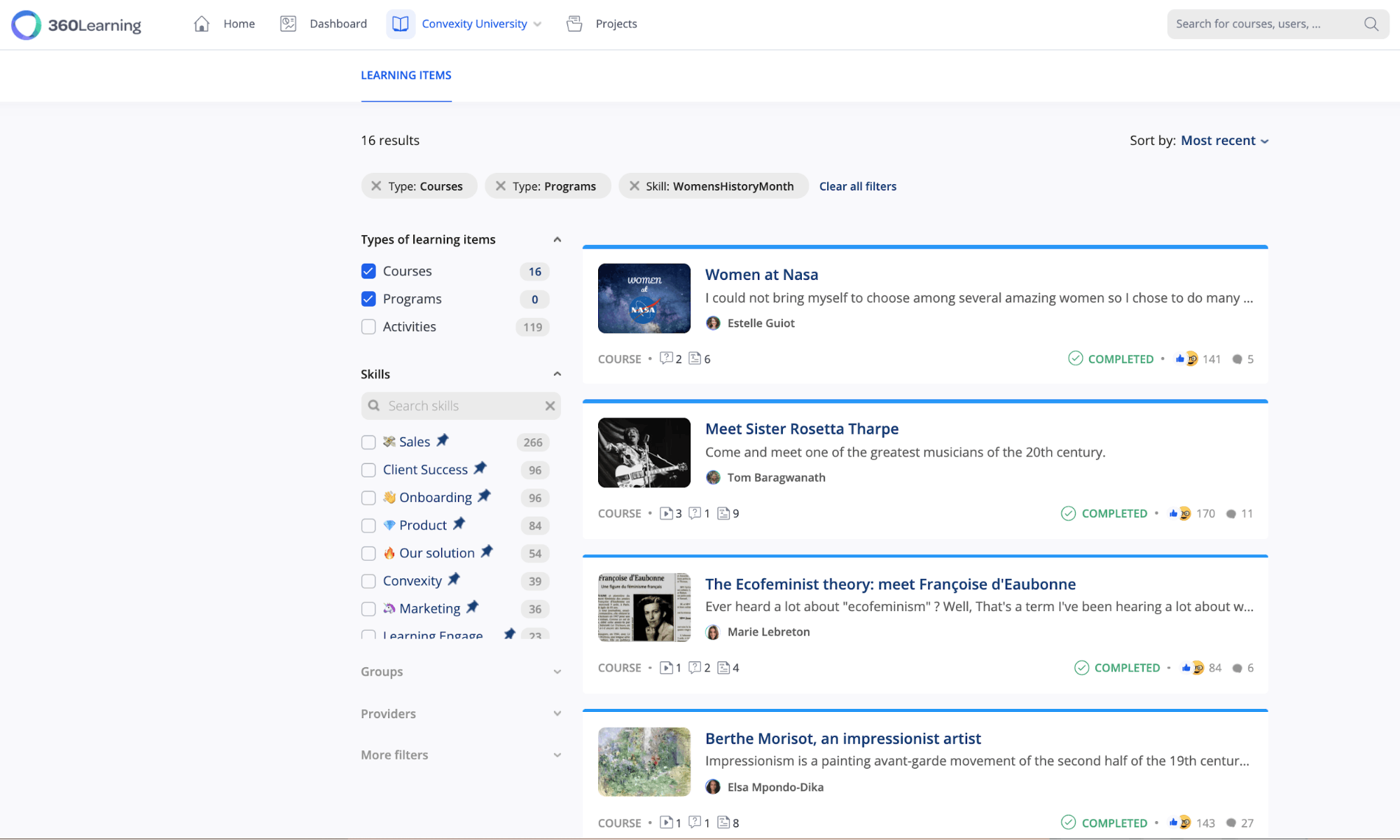
Women’s History Month ideas: a campaign in 3 phases
Our DE&I group had plenty of ideas to celebrate Women’s History month, and we decided to launch a dedicated campaign with 3 components: a learning campaign with courses created by 360Learners, an Employee Resource Group (ERG), and a coaching program. Here’s how we launched each of them.
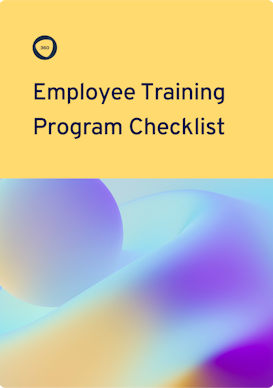
Make sure you cover all your bases.
By providing your contact info, you agree to receive communications from 360Learning. You can opt-out at any time. For details, refer to our Privacy Policy.
Idea #1: Women’s History Month learning campaign
At 360Learning, A learning campaign is a series of courses a learner can consume asynchronously on a given theme. We typically build them to last one month, with a new course published every week, or sometimes every day.
For this learning campaign our theme was, naturally, women who made history, be they activists, artists, engineers, or outstanding women from any other field. The campaign consisted of bite-sized courses, created by any 360Learner who wanted to participate.
How we launched our Women’s History Month learning campaign:
1. Engage L&D and DE&I experts first
If you're thinking of replicating this kind of learning campaign at your place of work, engage your L&D and DE&I experts first. This will ensure you create engagement and have a few people committed on your ‘sign-up sheet’ before sharing it with everyone.
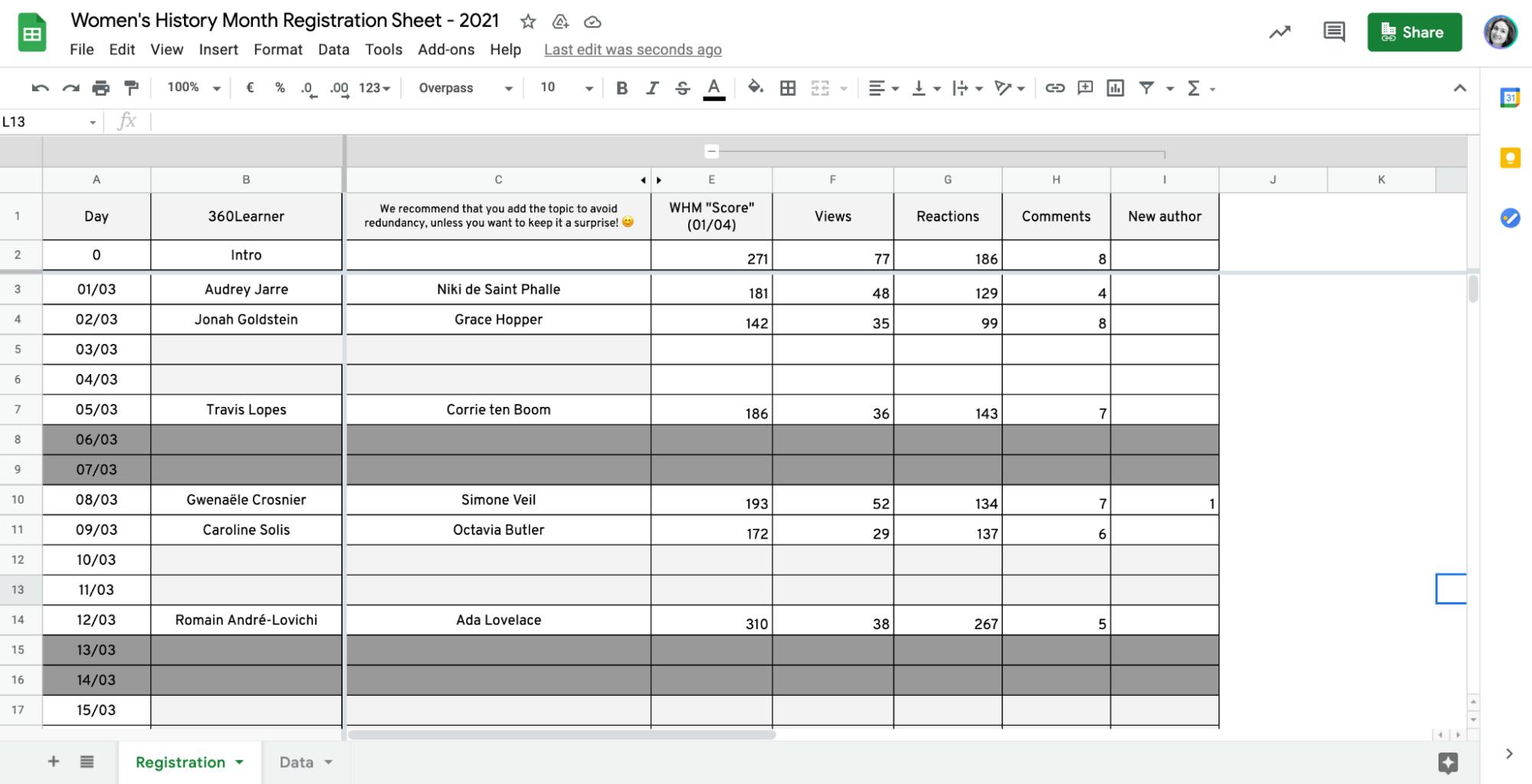
Reach out individually to people if need be to make sure you have this initial momentum. With a few names already down, the rest of your colleagues will be more inclined to participate.
2. Announce the campaign with a bang
Needless to say, the campaign’s success depends on employees' participation. So we made sure the whole company knew this was happening.
Using a calendar invite, Trello board, and Google sheet, we invited all employees to sign up to create a bite-sized course using 360Learning’s authoring tool.
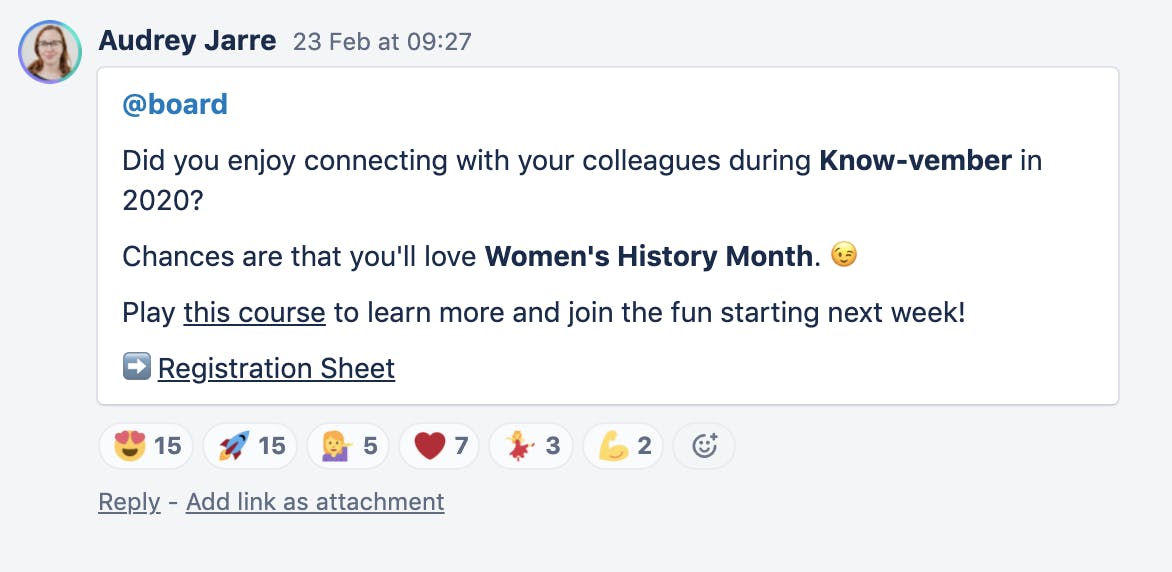
We included an entire course on 360Learning to explain the initiative in greater detail. After we made an initial big announcement to generate a burst of interest, we kept low-key reminders going throughout the month.

3. Encourage participation with L&D office hours
To encourage new authors (people who have never published a course before on our learning platform) to participate, we hosted extra L&D office hours that month for people who wanted feedback on their course before sharing it with the whole company.
This helped get people even more comfortable with our learning platform, while sharing their knowledge on a topic that is dear to them.
We had a good balance of new authors (people who have never published a course before) and seasoned experts to get the best of both worlds:
- It gave the former a chance to get to know our learning platform better.
- It allowed the latter to shine, showcasing their best skills and inspiring others to do the same.
4. Keep courses evergreen
We used a tagging system to keep the courses findable, so that even after March, people can still locate these courses by searching the skill #WomenHistoryMonth in their platform catalog.

5. Increase engagement with gamification
To keep it fun and engaging, we decided to offer first, second, and third place prizes to our participants.
We considered the winner the course that got the most views, Reactions, and comments. What we value most is always the engagement! We decided our prize was to reimburse the winners for a feminist book, a fiction novel written by a woman, or a biography of a woman of their choice from their favorite bookstore.
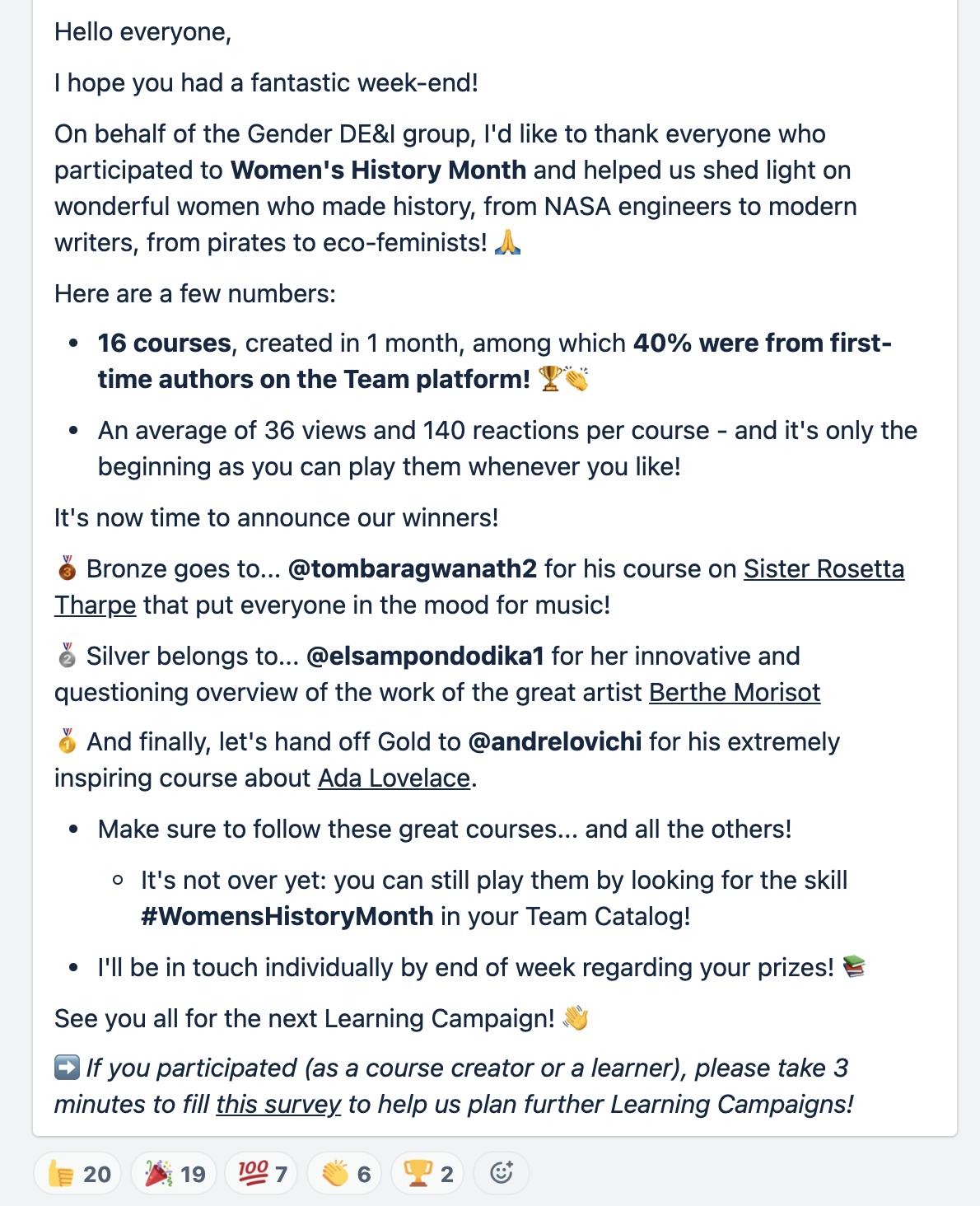
Throughout the campaign, we were sure to emphasize the key message: Learning can be done continuously, on the go, on mobile, and doesn’t have to be formal.
Although the L&D and DE&I group had a blast launching this program, we also wanted to make sure our participants felt the same way. For that, we decided on a few ways to measure whether the initiative could be considered a success.
After everyone's hard work and enthusiasm for the projects, here’s how we (in a quantifiable way) measured the success of our campaign:
- NPS: on a Net Promoter Score scale, we measured how well course creators and learners enjoyed the course.
- Reach: This was measured in views of our courses, Reactions, and other similar metrics. We were looking to see if these courses got more eyeballs on it than others in our library.
- Number of new authors: These kinds of initiatives are great ways to get newbies to start authoring courses on our platform. In this case, 40% of the authors that created courses were doing so for the first time. Not only does this mean they’re living our Collaborative Learning value, but they can more easily become brand ambassadors.
This learning campaign was an excellent way for employees to build connections, source institutional knowledge, and spread awareness about our theme of women of history. But this was only the tip of the iceberg. Now, it was time to move on to phase two.
Related: How to Develop Anti-Bias and Diversity Training That’s Truly Effective
Idea #2: Employee Resource Group (ERG) event: Women in the workplace
In phase 2, we wanted to build even more interaction and participation. That’s why we launched 360Learning’s first-ever ERG (Employee Resource Group) on the theme of women in the workplace.
As a reminder, an ERG or affinity group is a group intended to provide a safe space for employees who identify with a specific group—and their allies—to connect about topics related to that group, as well as support one another's growth, and advocate for their needs.
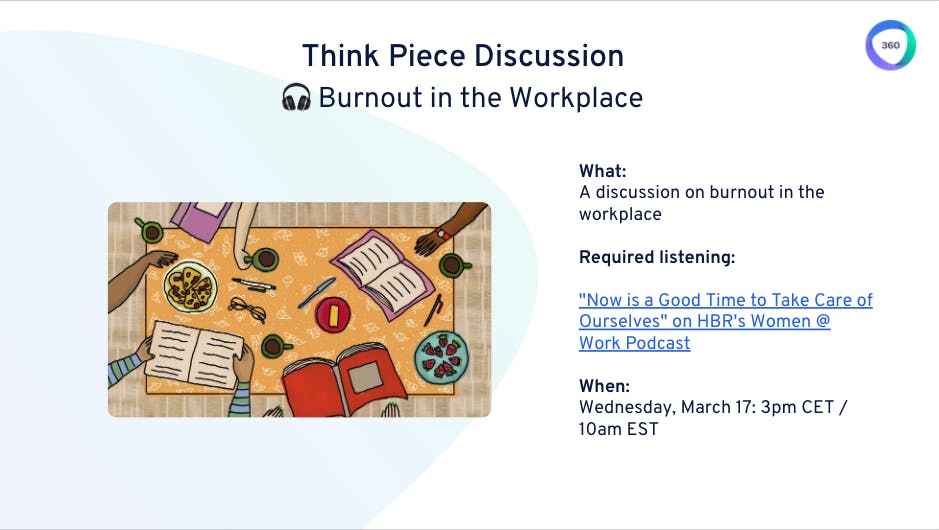
How we kicked-off our first ERG event:
1. Start with something digestible
We made the decision to center our first group event around a podcast. Why a podcast? It’s a smaller time commitment for participants than a book club, and would therefore make the event more inclusive (not everyone has the time or mental bandwidth to read a full book.)
2. Boost participation with reminders
We encouraged people to carve out an hour in their workday—even slotting it in on a calendar invite—to be sure people didn’t forget. We hoped this would boost participation rates, and it did.

3. Pick a salient topic
We chose a topic that would be relatable and timely: burnout. This was especially salient because of the COVID-19 pandemic. We settled on an episode from the fantastic HBR series “Women @ Work”.
Especially for a first try, the event was a huge success: we had a great turnout and found it was a fantastic way to build community across our international teams, with veteran 360Learners, and newbies alike sharing what they learned through our journeys as women in tech companies and beyond!
Employees responded well to the event, and left encouraging feedback for our main organizer on our internal recognition system on 7Geese:
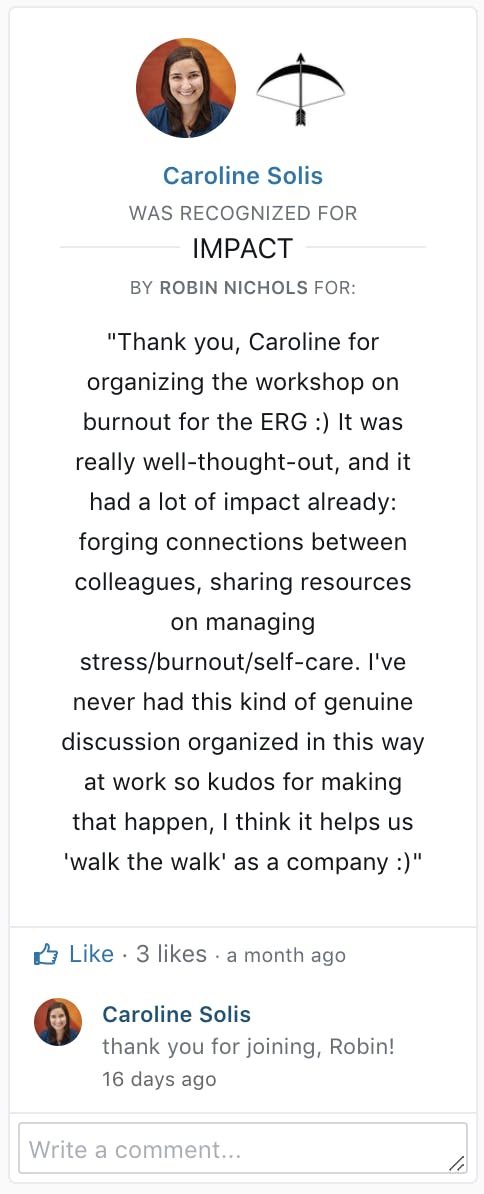
Idea #3 Coaching program for Women: Women@360
The last phase of our Women’s History Month campaign was to open applications for a developmental coaching program at 360Learning.
The program is for women aiming for leadership positions in their careers. Soft skills training and opportunities for self-reflection—among other initiatives—are good tools to start closing the gap between men and women in leadership.
Launching this program during Women’s History Month helped us drive our message home: We are inspired by women and want more of them to be in the spotlight and part of our exec team.
Here are a few of the topics that women at 360Learning could elect to be coached on:
- Managing remote teams,
- Developing your listening skills,
- Identifying and dealing with the factors that cause you stress,
- Preparing and leading effective meetings,
- Successfully managing your internal mobility, etc.
As you might expect, we decided to start small, with a 5 or 10-person pilot, to learn what works, before moving on to more ambitious goals.

Pro Tip: Even if you don’t work with an external coaching provider, why not take this as an opportunity to launch a small-scale mentorship program within your own organization. Sky's the limit!
What next? Ideas for future DE&I programs
Thinking of recreating these kinds of initiatives at your company and don’t want to wait for next year’s Women’s History Month?
There are many more topics you can take action on all year round:
- Lunar New Year
- Black History Month (February)
- Poetry Month (April)
- Latinx/Hispanic Heritage Month (September)
- LGBT History Month (October)
In fact, who needs an official date to talk about what matters to them, anyway? Any month is a good month to launch a learning campaign or employee support program. All you need is the right approach and an easy platform to coordinate everything.
Want to learn more about Collaborative Learning—what it is, why it’s our North Star, and the benefits for L&D teams and learners alike? Our article explains it all.


